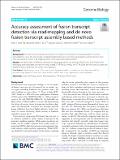| dc.contributor.author | Regev, Aviv | |
| dc.date.accessioned | 2020-04-30T17:31:22Z | |
| dc.date.available | 2020-04-30T17:31:22Z | |
| dc.date.issued | 2019-10-21 | |
| dc.identifier.issn | 1474-760X | |
| dc.identifier.uri | https://hdl.handle.net/1721.1/124943 | |
| dc.description.abstract | Background: Accurate fusion transcript detection is essential for comprehensive characterization of cancer transcriptomes. Over the last decade, multiple bioinformatic tools have been developed to predict fusions from RNA-seq, based on either read mapping or de novo fusion transcript assembly. Results: We benchmark 23 different methods including applications we develop, STAR-Fusion and TrinityFusion, leveraging both simulated and real RNA-seq. Overall, STAR-Fusion, Arriba, and STAR-SEQR are the most accurate and fastest for fusion detection on cancer transcriptomes. Conclusion: The lower accuracy of de novo assembly-based methods notwithstanding, they are useful for reconstructing fusion isoforms and tumor viruses, both of which are important in cancer research. | en_US |
| dc.description.sponsorship | National Cancer Institute (U.S.) (Grant U24CA180922) | en_US |
| dc.description.sponsorship | National Cancer Institute (U.S.) (Grant R50CA211461) | en_US |
| dc.description.sponsorship | National Cancer Institute (U.S.) (Grant R21CA209940) | en_US |
| dc.description.sponsorship | National Cancer Institute (U.S.) (Grant U01CA214846) | en_US |
| dc.language.iso | en | |
| dc.publisher | Springer Science and Business Media LLC | en_US |
| dc.relation.isversionof | 10.1186/s13059-019-1842-9 | en_US |
| dc.rights | Creative Commons Attribution 4.0 International license | en_US |
| dc.rights.uri | https://creativecommons.org/licenses/by/4.0/ | en_US |
| dc.source | BioMed Central (BMC) | en_US |
| dc.title | Accuracy assessment of fusion transcript detection via read-mapping and de novo fusion transcript assembly-based methods | en_US |
| dc.type | Article | en_US |
| dc.identifier.citation | Haas, Brian J. et al. “Accuracy assessment of fusion transcript detection via read-mapping and de novo fusion transcript assembly-based methods.” Genome biology 20 (2019): 213 © 2019 The Author(s) | en_US |
| dc.contributor.department | Massachusetts Institute of Technology. Department of Biology | en_US |
| dc.contributor.department | Koch Institute for Integrative Cancer Research at MIT | en_US |
| dc.relation.journal | Genome biology | en_US |
| dc.eprint.version | Final published version | en_US |
| dc.type.uri | http://purl.org/eprint/type/JournalArticle | en_US |
| eprint.status | http://purl.org/eprint/status/PeerReviewed | en_US |
| dc.date.updated | 2020-01-28T19:09:16Z | |
| dspace.date.submission | 2020-01-28T19:09:18Z | |
| mit.journal.volume | 20 | en_US |
| mit.journal.issue | 1 | en_US |
| mit.metadata.status | Complete | |
